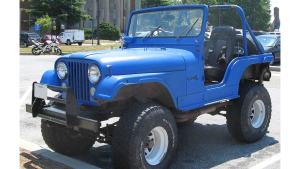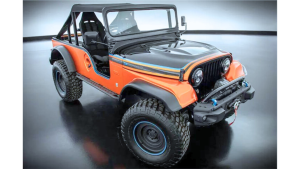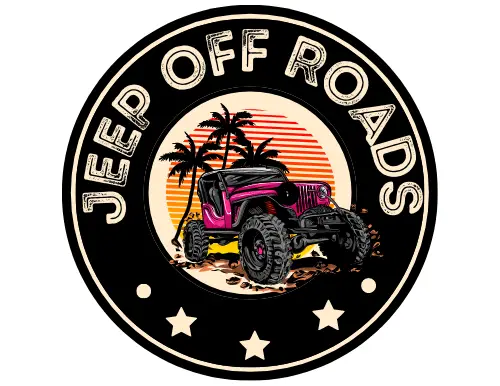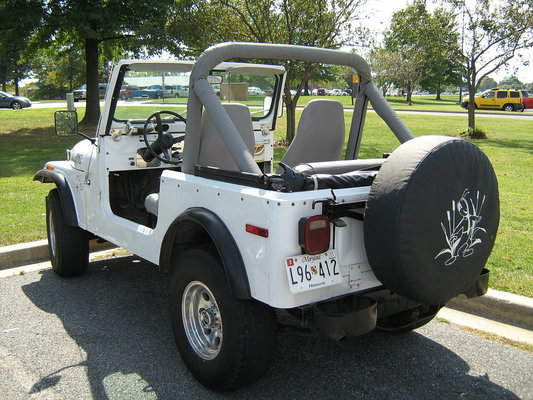In case anyone has been hearing about the Jeep CJ with little or no knowledge about its history, features, and how the vehicle has been able to gather the immense popularity it enjoys to date.
This article clearly defines/highlights “what does CJ stand for Jeep,” giving a breakdown of how it became a household brand/name across the globe.
Especially how it rose above other utility vehicles to become the most prominent design in Jeep’s history.
For individuals who own/drive a Jeep CJ or want to pick up one soon (for immense off-road experiences/adventures). The information contained here will be of top interest.
Why CJ Jeep is Popular?
The CJ’s popularity is connected to its wide level of acceptance by Jeep enthusiasts across the world, especially individuals who are committed to or fascinated by off-road adventures.
The CJ-5 made history as the 1st civilian vehicle specially built/designed to cater to off-road adventures/drives.
A few years later, the CJ-7 model came with several significant upgrades, positioning itself as the perfect/ideal replacement for the CJ-5.
Before the launch/introduction of the CJ-7, the brand had already become a popular name among Jeep enthusiasts. However, the CJ-7 created a further expansion in the already growing market.
Today, the CJ-7 is highly rated by new and old Jeep owners, many of whom refer to it as a symbol of freedom on rough trails, making off-road drives fun and adventurous.
What CJ Stands For Jeep
This section briefly discusses the Jeep CJ, especially the history behind the commercial launch and what the acronym stands for.
The “C” stands for Civil, while the “J” stands for Jeep. So, you may decide to call it CJ (the short form) or Civil Jeep (the full/complete form).
CJ Jeep History
Before the Jeep CJ was launched, the Jeeps at that time were commonly used in the military, especially as a means of transportation during World War II.
In 1942, the US Department of Agriculture conducted a test using the Willys military Jeep in the place of a tractor on the farm. It was also tested/used as a general-purpose vehicle.
Both attempts/trials deliver remarkable outcomes. That marked the first Jeep appearance/use for activities that had nothing to do with the military.
During this period, Willys-Overland realized how much sales a Civilian Jeep could make/generate.
Two years later (in 1944), plans and arrangements for the commercial production of a Civilian Jeep started/began to serve the interested members of the public.
Starting from 1944 until 1986, when production was brought to a halt.
The CJ was designed across many models) numerous corporate/parent manufacturers (Willys-Overland, Willys Motor, Kaiser-Jeep, and American Motors Corporation).
Over one million five hundred thousand units were produced in the process.
It is important to state that some CJs were built for the export market (CJ-6 and CJ-10), limiting their popularity in the United States of America.
CJ-10 was designed and offered as the final creation of the CJ series, bringing an end to a remarkable run in the history of Jeep production.
The CJ is not only a big part of the Jeep’s history. It also makes up a significant part of American history, which shows why it is widely referred to as America’s Workhorse.
In the history of Jeep (from inception to date), the CJ still remains a significant influence, retaining its personality as one of the most influential designs in Jeep’s history.
Some people believe that no design comes close in the history of utility vehicles, making it the most successful.
Jeep CJ Features
This section highlights/discusses some of the features shared among all the CJ (Civilian Jeep) series/models.
The information sheds more light on why the Jeep CJ enjoys exceptional popularity, recommendations, and excellent ratings, ahead of many other designs, including the latest/new options in its category.
01. Construction
You must have heard the phrase, “king of off-roader or king of off-road vehicles,” bestowed to the CJ.
The name or claim isn’t out of proportion. It is deserving, which is evident in how it navigates roads/paths that other vehicles are unsure/scared to follow or drive through without any restrictions.
02. Dimensions
All through the CJ’s lifetime (from the first production through the last), each model experienced an increase in size, posing as a bigger/larger version of the previous design.
For instance, the CJ2A has a wheelbase and an overall length of 80 inches and 1227.75 inches, respectively.
When the first sets of CJ-5 were released (from the first release until 1971), the wheelbase increased by one (1) inch, delivering an 81-inch wheelbase.
The CJ-5, released/launched after 1971, added a 2-inch wheelbase, delivering 83-inch in the process.
Nevertheless, the overall length across all the CJ-5 versions remained intact (139-inch).
When the CJ-7 was launched, it added an astonishing 10.3-inch to the wheelbase and 9-inch to the overall length, compared to the post-1971 CJ-5.
The CJ-7 wheelbase and overall length arrived at 93.3 inches and 148 inches, respectively.
03. Frames and Bodies

Here is a unique feature that extends across all CJ models. The frames and bodies are engineered/built separately for improved off-road performance.
04. No Door Use/Operation
The CJs are designed to be used or driven across the road and off-road without necessarily having the doors on.
Hence, making them an exciting/fascinating choice for adventurous individuals who are always intentional about having a close view/contact with nature.
05. Metal Interior
The CJ interiors are made from high-grade metals for improved strength and robustness, retaining the feel and touch of its predecessor, the Willys military Jeep.
The interior, coupled with other solid/rugged structures of the vehicle, says a lot about why many people (to date) rate the CJ well above other Jeeps released after production stopped.
06. Modification
If vehicle tinkering is a hack you’d always want to perform. Especially for someone who wants an engine that makes the Jeep run faster than usual by making some specific modifications/upgrades.
The CJ may be the most ideal/suitable model to settle with or go for. Thanks to its straightforward design.
07. Handling
The CJ models are carefully designed, using the best quality construction materials available at that time.
This says a lot about how long they stay in top conditions, with few complaints/issues reported by users/owners.
The interior comfort is another exciting feature possessed by the CJs, making every ride adventurous (fun and filled with excitement).
08. Ground Clearance
To date, the CJ remains a top contender for this feature/attribute.
With a higher ground clearance than many other models/designs in its category, even the latest designs (the ones that were launched after the CJ production stopped).
CJs deliver beasty performances on irregular/bumpy paths or terrains without negative impacts or damages caused to the Jeep’s bottom.
While the ground clearance from the factory is impressive/adequate to keep the vehicle safe from collisions and other elements/conditions that could result in expensive repairs.
The ground clearance could be raised/higher by using a lift kit and integrating bigger wheels/tires.
09. Chassis
As technological advancement continued to take shape, the CJ was not left out. The manufacturers were able to take advantage of innovations happening at that time to deliver a design that met the trend and beyond.
This claim is evident in the improvement of the suspension system across the CJ models/series.
For instance, the CJ2A came/was built using the front/rear rigid axles coupled with leaf springs. Also, the steering system had a configuration known as “worm-and-peg.”
On the other hand, the CJ5 and CJ7 series/models came with front & rear live axles. The leaf springs were semi-elliptic and had a steering system configuration known as a “Saginaw recirculating ball.”
Amidst the difference in the axles, leaf springs, and steering system, every CJ model uses 4-wheel drum brakes.
However, the late CJ-7s had the front discs option available. Also, the CJ2A, CJ-5, and CJ-7 came with 16-inch wheels/rims.
CJ Jeep Popular Year

The CJ popular year is unarguably the CJ-7, widely noted or referred to as an upgraded version of the CJ-5.
Its numerous exciting features contributed excessively to how accessible this model is to many average/regular drivers.
Note that most of the features, extras, or upgrades added to the CJ-7 were the first in Jeep manufacturing or production history.
For instance, the longer wheelbase, overall length, and the use of hinged doors.
Pros
- The largest/biggest CJ model ever created/designed
- Improved stability, thanks to its new/advanced chassis system
- Shock absorbers were designed to be installed/integrated close to the outside of the body
- Rugged construction, reinstating the CJ off-road dominance
- Available in or offered across various transmissions and engines
- The CJ-7 is known to retain its value impressively over a long period
Cons
- Finding a CJ-7 that is a top/excellent condition and with an average mileage could be challenging or sometimes impossible
Benefits of CJ Jeep
a) Ruggedness
With the CJ, the fear of getting stuck in poor road conditions or damaging expensive body parts during off-road adventures or when driving under extreme weather conditions is totally eliminated. Thanks to its rugged/rigid construction.
b) Availability
Despite being out of production for decades, the CJ, especially the CJ-7, can easily be located for purchase.
c) Value
The CJ remains a worthwhile purchase or investment for individuals interested in this brand to date.
Today, the average purchase price of the CJ-7 stands around $25,500 (as low as $18K and as high as $33K).
According to a released report by the NADA guide, that is about a $14,200 increase in value compared to the average retail price of about $11,300 that many early owners paid in 1980.
Nevertheless, the current selling price (how high or low) is dependent on the vehicle’s condition. The better the state/condition of the vehicle (low mileage and less wear/tear), the higher the price.
d) Fuel Tank/Storage
The CJs are designed to store/hold a large amount of fuel, lasting for an extended period (depending on use/activity) until a refill could be considered.
For instance, the CJ-7 Jeeps can hold up to 15.1 gallons of fuel in the tank.
Common Problems of Jeep CJ
a) Difficulty in Finding a CJ in a Top Condition
As we stated earlier, getting a CJ is not as difficult as anyone could have thought, considering how long the brand has been around and putting the last production into according, spanning several decades.
However, getting the one in the best condition possible and without much mileage under its belt could be challenging, considering how most owners subject the vehicle to heavy off-road use, which could have caused excessive wear and tear over time.
b) Crack Mount
The stock mount can crack easily, even when you do not engage in extensive off-road drives or while you retain the use of small tires.
Whenever the mount cracks, it affects the steering operation.
This issue has been appropriately addressed by the numerous quality aftermarket designs available today.
c) Old Accessories
Although the CJ underwent a series of modifications and upgrades during the production lifetime, most importantly, it adopted various technological advancements at that time.
It is fair enough to say its glory days are behind when it comes to accessories and computerized dashboard technology, considering the modern/latest Jeep designs we have today.
Individuals who are more captivated by modern accessories/technology than off-road performance or dominance might not appreciate the CJ enough, settling for any of the latest models instead.
d) Clutch Linkage Failure
During off-road adventures, the body and frame may get twisted, leading to clutch linkage failure due to poor construction.
Frequently Asked Questions
Which Vehicle Replaced The CJ After Production Was Brought To a Stop?
The CJ production started in 1944 and ended in 1986, enjoying incredible success during its dominating run, opening doors for the huge acceptance and patronage that the utility vehicles enjoy to date.
When the CJ era ended, the YJ wrangler was launched as the successor, running on a similar suspension (leaf spring). However, the YJ wrangler operates wider springs than the CJs.
Where Can I Buy a CJ Jeep?
Since the CJ is no more in production, hence, there is no such thing as a new CJ Jeep. A well-maintained CJ Jeep? Yes.
An interested buyer can check several online marketplaces to search for the series/model of top interest to them (in terms of price and performance expectations).
One of the leading websites you can check is JDpower.com.
Once the CJ model/series is inserted in the search/filter box, various results that match the search will be displayed, showing the seller’s location, price, and vehicle mileage.
What Comes Next After Finding a Suitable Offer?
Once anyone finds a befitting offer, you can then schedule an inspection with the seller to check the vehicle’s condition.
Individuals who do not know what to look out for to ascertain top conditions or decide if the price is worth it should not hesitate to go with an experienced CJ mechanic.
Who Should Buy CJ jeep?
The CJ, most especially the CJ-7, is designed for adventurous individuals (off-road enthusiasts) who desire a vehicle that can drive across terrains/paths that other cars can’t pass through for fear of being stuck or the expensive damage that could arise from such an attempt.
Individuals who are intentional about freedom, especially when driving across treacherous terrains and do not want fear or uncertainties to cut their adventure short. The CJ assures the confidence they desire/seek.
Final Words
We believe the sections under the article “What does CJ stand for Jeep” have given adequate information about this creation/design for enhanced clarity.
Especially where it ranks among other designs/brands available today.
When you look at the features carefully and compare them with some/all of the utility vehicles out there, one thing is clear.
From the inception of the CJ through the period that the production lasted.
Even to date, no off-road jeep can withstand its efficiency, stability, and performance on irregular or bumpy terrains.
https://www.motortrend.com/how-to/jeep-cj5-buyers-guide-history/

Hello there, this is Thomas Byrd. I am a professional car mechanic who leads a team of junior mechanics in a repair and restoration shop. In the beginning, I used to work for a jeep service center as a basic worker. From there I keep learning, changed my job 2 times and now I am a professional who leads a group of mechanics. Though a have expertise in the jeep, I know very well about all types of cars. To share my knowledge and skills with others I have created this blog website. Whenever I get free time from work I give my time to my blog.

